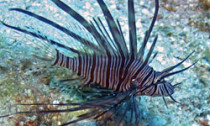
Coral reefs in the Caribbean and along the U.S. Atlantic coast are being threatened by a growing population of voracious and invasive lionfish. The red-striped predator, native to the Indian and Pacific oceans, is a popular aquarium fish, and was likely released into Atlantic waters in the early 1990s. With no natural predators there, the lionfish quickly multiplied, reducing native fish populations by up to 80 percent.
Researchers from Oregon State University recently participated in an expedition to an artificial reef about 90 meters deep off the Florida coast. They were surprised to find a large number of unusually large lionfish – about half a meter long.
OSU research fellow Stephanie Green warns that they could migrate to shallower depths and eat many of the fish there, as well. In addition, in many species, large fish can reproduce more efficiently than smaller ones. Green says the control measures being used to reduce lionfish populations at shallower depths – catch them and let people eat them – are not as practical in deeper waters.
While OSU scientists continue to look for ways to combat the lionfish, researchers express concern that the invasion, along with overfishing, pollution and the warming ocean, could be too much for the reef ecosystems to survive.











Social Profiles